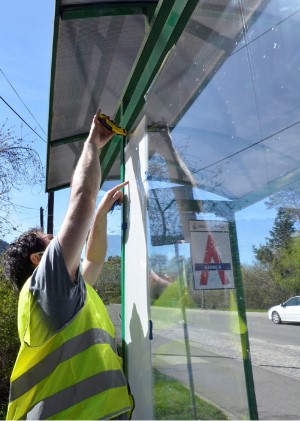
The challenge
Most flight tunnel tests to study bird-window collisions appear to have been conducted in highly darkened flight tunnels, that will lack important shorter-wavelength light cues, and/or with mirror-reflected light will alter the polarization of light. The challenge lies in collecting data on the effectiveness of bird collision mitigation products under near-real-world conditions and taking avoidance behavior into account.
Experimental setup
The flight tunnel consisted of a long-darkened release tunnel that opened into a larger day-lit tunnel constructed with fine netting, where the windows were placed. Birds experienced natural daylight in the netted part of the tunnel during all trials. Further, avoidance behavior was considered.

Trails
Each bird was exposed to all three treatment groups in a balanced order so that the series of presentations and repeated exposure to the flight tunnel did not bias responses by birds. The repeated-measures experimental design was chosen as this accounts for among-bird variation in flight behavior that otherwise requires large sample sizes. Birds experienced each treatment group on a separate day.
Treatment groups:
- Control: External film (not BirdShades) on exterior side of window which had similar physical and spectral-reflectance properties to BirdShades except for the specific UV-pattern.
- Treatment: BirdShades on exterior side of both windows
- Forced choice: One window received the control film and one window received the treatment film (setup currently used in industry dark flight tunnels)
Results
94,4% (zebrafinches) and 89,2% (cowbirds) of birds recognized BirdShades as an obstacle in a traditional forced choice setup as currently used by the industry. Further, the scientists discovered, that the zebra finches and cowbirds flew approximately 25% slower when the windows were treated with BirdShades.
Additionally, the research team also tested different testing scenarios such as both conditions (no choice) which could be more ecologically relevant than the forced choice test scenarios.

This study in the media
- BirdShades trials yield better methodology for testing bird-window collision deterrents
https://www.wm.edu/news/stories/2020/birdshades-trials-yield-better-methodology-for-testing-bird-window-collision-deterrents.php - Eine Frage des Durchblicks: Für Menschen durchsichtige Klebefolie schützt Vögel vor Kollisionen mit Scheiben
https://ethologisch.de/birdshades-klebefolie-schuetzt-voegel-vor-kollisionen-mit-scheiben/ - Ultraviolet-Reflective Film Reduces the risk of Bird-Window Collisions
https://www.youtube.com/watch?v=Q6kwVOxjZy
FAQ’s
- Do birds get used to the flight tests?
Each bird was exposed to each of three treatment groups, in a balanced order so that the series of presentations and repeated exposure to the flight tunnel did not bias responses by birds. Birds experienced each treatment group on a separate day, to minimize changes in behavior associated with repeated exposure to the flight tunnel and window. - Would it make sense to test with a larger sample size?
This study was conducted with a repeated-measures experimental design. An analogy might help to understand how this well-established scientific testing method works: Imagine you wanted to test whether a drug reduced blood pressure. A repeated-measure design would take a bunch of patients and study their blood pressure before and after taking the drug. The within-individual change in blood pressure is the effect of the drug. The design of current traditional flight-tunnels applies the drug to some people and not others and then studies the difference in blood pressure between those two groups. There are lots of reasons why one group of people might differ in blood pressure from another group: diet, lifestyle, stress, other medications they are taking, underlying health conditions, etc… So, a big sample size is needed to have confidence that all other explanations between the two groups are randomized. You don’t need that large sample size with a repeated-measures design, as you are studying the change within an individual and so you immediately control for all those other confounding factors. Hence, you can use a much smaller sample size because you are isolating the effect you’re interested in (i.e. the effects of the drug in the analogy, or the effects of a window treatment in the experiments of this study). If the sample size was too small there wouldn’t be statistical support for the conclusions. These principles of experimental design and statistical analysis are well established in all kinds of scientific literature. And they are especially relevant to measure of behavior (such as flight behavior toward a window) because there are so many reasons why the behavior of one individual might differ from the behavior of another. It’s not that one approach is better than another, they are simply different. With the traditional dark flight-tunnel setup a large sample size to isolate the effect of the window treatment is needed. With the approach in this study a large sample size is not needed as it focuses on the changes in flight within individual birds as they experience different windows. The effects of the window treatment are much more apparent because the study standardizes/controls for all the reasons why there are among-individual differences in flight behavior. - Why did the scientists use these two bird species?
This study used two different species to determine if there are effects between wild caught cowbirds and captive held zebra finches. In the currently common used dark-flight tunnel many species are used, but unfortunately it is not evaluated how different species react. - Why is it important to consider the avoidance behavior?
Avoidance behavior is an important metric to measure whether a treatment can mitigate bird-window collisions or not. Active avoidance means that a bird sees the treatment and makes an active decision to avoid it.

